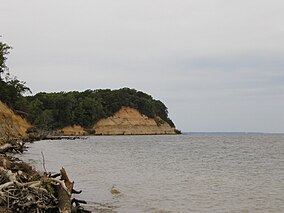Calvert Cliffs State Park: Difference between revisions
m Fixing section headings (task 5) |
ZeWrestler (talk | contribs) Now has a Commons Cat |
||
| Line 43: | Line 43: | ||
==See also== |
==See also== |
||
{{commons category}} |
|||
*[[Dominion Cove Point LNG]], the large industrial complex visual offshore from the beach is its receiving station |
*[[Dominion Cove Point LNG]], the large industrial complex visual offshore from the beach is its receiving station |
||
Revision as of 16:42, 5 May 2013
| Calvert Cliffs State Park, Maryland, USA | |
|---|---|
IUCN category V (protected landscape/seascape) | |
 The namesake Calvert Cliffs in Calvert Cliffs State Park | |
| Location | Calvert County, Maryland, USA |
| Area | 1,313 acres (5.31 km²) |
| Governing body | Maryland Department of Natural Resources |
Calvert Cliffs State Park is a state park in Lusby, Maryland (in Calvert County). Calvert Cliffs is on the eastern side of the Calvert Peninsula and situated on the west-side of Chesapeake Bay.[1] On the 1612 John Smith map, the site is called "Rickard's Cliffes".
The cliffs are a short distance south of Calvert Cliffs Nuclear Power Plant operated by Constellation Energy.
Formations
The park is known for the abundance of mainly Middle Miocene sub-epoch fossils, which can be found on the shoreline. It contains the type locality site of the Early to Middle Miocene Calvert Formation. These rocks are the sediment from a coastal ocean that covered the area during that time. The age of the formation is (19-)18-15(-14) million years ago (Ma), i.e. it extends essentially over the Hemingfordian stage. This formation occurs in Maryland and neighboring Virginia.
In addition, rocks of the younger Choptank and the St. Marys Formations are exposed here. This makes Calvert Cliffs State Park extremely interesting for its paleoclimatology and paleontology, because the accessible strata provide a good record of the Middle Miocene Climate Transition and document a minor mass extinction event — the "Middle Miocene disruption". Fossil collecting and "rockhounding" are permitted on the beach, but access to the Cliffs is no longer open due to erosion.
Paleontology
The Calvert Formation is notable for its plentiful fossil shark teeth. Especially popular among "rockhounds" are those from giants such as Carcharocles and the famous Megalodon (which is often included in Carcharocles).
The ancestral baleen whale Eobalaenoptera harrisoni and the merganser Mergus miscellus were described from the Virginian part of the formation. From the uppermost layer, deposited 15-14 Ma, they represent the oldest known member of their family and genus, respectively. Some remains of a prehistoric loon (Gavia) from the lowermost parts of the Calvert Formation, dating back nearly 18 Ma, are the oldest records of that genus from North America, and among of the oldest worldwide.
Ecology, Hunting, and Fishing

Calvert Cliffs State Park is mostly forested, but also includes some wetland areas, and a small pond open for fishing. 550 acres of the park are open to hunting upland game, turkey, and deer. The park is rich in biodiversity and is home to numerous species of plants and animals. eBird has records of at least 163 species of birds observed in the park.[2]
See also
- Dominion Cove Point LNG, the large industrial complex visual offshore from the beach is its receiving station
References
- ^ U.S. Geological Survey Geographic Names Information System: Calvert Cliffs State Park
- ^ Bird Observations at Calvert Cliffs State from eBird, an online database of bird distribution and abundance (accessed May 31, 2011)
